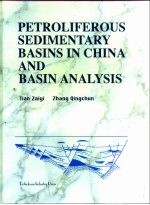

中国含油气沉积盆地论:英文版PDF电子书下载
- 电子书积分:11 积分如何计算积分?
- 作 者:田在艺,张庆春
- 出 版 社:北京:石油工业出版社
- 出版年份:1997
- ISBN:7502121293
- 页数:276 页
CHAPTER 1 INTRODUCTION TO PETROLIFEROUS SEDIMENTARY BASIN 1
1.1 Sedimentary Basin as the Basic Geological Unit for Oil/gas Generation and Occurrence 1
1.2 Controlling Factors of Sedimentary Basins on Oil/gas Generation and Occurrence 3
1.2.1 A sedimentary basin formed under a certain tectonic environment is favorable to oil/gas generation and evolution,if under long-term continued subsidence 4
1.2.2 Multi-cyclicity of crustal movement leads to multi-cyclicity of structural evolution and deformation of the basin and the formation of source-reservoir-seal combinations at different stages and various types of oil/gas pools 4
1.2.3 Control of palaeoclimate on oil/gas bearing basins 6
1.2.4 Sedimentary system,facies and diagenetics control the richness of oil/gas pools 6
1.2.5 Organic-rich source rock is the basis for oil/gas generation,and oil-generating sag controls the distribution of oil/gas pools 9
1.2.6 Appropriate palaeo-geotemperature is critical to oil/gas generation 11
1.2.7 Oil/gas migration is a link in the whole process of generation,migration and accumulation,and hydrodynamics has an important influence on migration and accumulation 12
1.2.8 Regional structural style controls the type and distribution of traps 13
1.2.9 Temporal and spatial matching of source,reservoir,seal,migration,trap,preservation is critical for an accumulation to become a pool 13
CHAPTER 2 REGIONAL GEOLOGY OF CHINA 17
2.1 Regional Tectonic Units and Their Spatial Distribution 17
2.1.1 North China stable continent tectonic province 19
2.1.2 Tarim stable continental tectonic province 20
2.1.3 Qaidam stable continent tectonic province 21
2.1.4 Yangtze stable continent tectonic province 21
2.1.5 Gondwana northern margin tectonic province 22
2.1.6 Tianshan-Hinggan/Mongolia-Jilin/Hei-longjiang fold tectonic province 24
2.1.7 Qinling-Qilian fold tectonic province 25
2.1.8 Kunlun fold tectonic province 27
2.1.9 Songpan-Garze fold tectonic province 27
2.1.10 Karakorum-Tanggula-Sanjiang fold tectonic province 28
2.1.11 South China fold tectonic province 29
2.1.12 East continental margin tectonic province 30
2.2 Historical Development of Crustal Structure 31
2.2.1 Fuping Period 31
2.2.2 Liuliang Period 33
2.2.3 Jinning Period 35
2.2.4 Caledonian Period 37
2.2.5 Hercynian Period 41
2.2.6 Indosinian Period 45
2.2.7 Yanshanian Period 49
2.2.8 Himalayan Period 53
CHAPTER 3 TYPES OF PETROLIFEROUS BASINS IN CHINA 57
3.1 Significance of Basin Classification and Previous Classification 57
3.1.1 Significance of basin classification 57
3.1.2 Previous basin classification 58
3.2 Types and Evolution of Petroliferous Sedimentary Basins in China 60
3.2.1 Basin types 62
3.2.2 Basin development and formation of Meso-Cenozoic superposed basins 74
CHAPTER 4 ANALYSIS OF PETROLIFEROUS SEDIMENTARY BASINS 83
4.1 Introduction 83
4.1.1 Significance and basic content of analysis of petroliferous sedimentary basins 83
4.1.2 Multi-factor synthetic analysis of petroliferous sedimentary basins 83
4.1.3 General guideline for analysis of petroliferous sedimentary basins 84
4.2 Analysis of Basin Subsidence and Burial History 87
4.2.1 Basin Subsidence and fill-up as well as their significance in petroleum geology 87
4.2.2 Mechanism of basin subsidence 89
4.2.3 Restoration of subsidence and burial history of sedimentary basins 91
4.3 Thermal Regimes and Thermal History Analysis of Sedimentary Basins 104
4.3.1 Geotherm and its significance to hydrocarbon generation 104
4.3.2 Geotemperature field and thermal regime of sedimentary basin 106
4.3.3 General methods for reconstructing thermal histories of sedimentary basins 115
4.4 Multi-cyclic Evolution of Basins and Multi-stage Association of Sourec-Reservoir-Seal 128
4.4.1 Multi-cyclicity of crustal movement and superposed basins 128
4.4.2 Multi-cyclic evolution of basins and multi-stage hydrocarbon-generating formation 129
4.4.3 Multi-cyclic sedimentary formations and multi-stage source-reservoir-seal associations 140
4.5 Depositional Systems,Diagenesis and Their Relationships with Hydrocarbon Accumulation 147
4.5.1 Depositional systems,sedimentary facies and temporal and spatial distribution of sedimentary basins 148
4.5.2 Sedimentary facies belt and relationship with hydrocarbon accumulation 157
4.5.3 Diagenesis and epigenesis of depositional systems and their relationships with oil and gas 162
4.6 Source Rock Evaluation and Analysis of Hydrocarbon-Generation History of Basins 165
4.6.1 Basic theory of hydrocarbon generation 166
4.6.2 Evaluation of source rocks in petroliferous basins 172
4.6.3 Quantitative calculation of hydrocarbon generation history 182
4.7 Palaeoclimatology and Hydrocarbon-Bearing Features of Sedimentary Basins 187
4.7.1 Palaeoclimatology and the principle of its reconstruction 187
4.7.2 Palaeoclimate condition and oil-bearing features of sedimentary basins 191
4.8 Hydrocarbon Migration and Hydrodynamic Analysis 199
4.8.1 Analysis of primary migration of oil and gas 199
4.8.2 Analysis of secondary migration and accumulation of oil and gas 207
4.9 Structural Styles,Trapping Types and Distribution of Hydrocarbon Accumulations 220
4.9.1 Structural styles and their major types in sedimentary basins 220
4.9.2 Structural styles and their distribution features of sedimentary basins in China 227
4.9.3 Types of hydrocarbon traps and association patterns of oil and gas accumulations 231
4.10 Analysis of Sealing Conditions of Oil and Gas Pools and Petroleum System 239
4.10.1 Analysis of sealing conditions of oil and gas pools 239
4.10.2 Petroleum system analysis 244
4.11 Basin Modeling Techniques and Their Application to Petroliferous Basin Analysis 252
4.11.1 Brief introduction to basin modeling techniques 253
4.11.2 2D basin modeling in Damintun sag of Liaohe depression 258
REFERENCES 268
- 《卓有成效的管理者 中英文双语版》(美)彼得·德鲁克许是祥译;那国毅审校 2019
- 《AutoCAD 2018自学视频教程 标准版 中文版》CAD/CAM/CAE技术联盟 2019
- 《跟孩子一起看图学英文》张紫颖著 2019
- 《AutoCAD机械设计实例精解 2019中文版》北京兆迪科技有限公司编著 2019
- 《复分析 英文版》(中国)李娜,马立新 2019
- 《张世祥小提琴启蒙教程 中英文双语版》张世祥编著 2017
- 《生物化学 本科临床 英文版》张晓伟 2018
- 《理想国 全英文原版》(古希腊)柏拉图著 2017
- 《Dreamweaver CC 2018标准实例教程 中文版》杨雪静,胡仁喜编著 2019
- 《Flash CC动画制作实用教程 中文版》麓山文化 2019
- 《养好五脏不生病 内脏运动保健法》张远声,张冬,张涛,张庆尧,张钰儿 2019
- 《农业农村面源污染防控技术》张庆忠,梅旭荣,朱昌雄主编 2019
- 《一级注册结构工程师专业考试 历年试题·疑问解答·专题聚焦 第8版》张庆芳,申兆武著 2018
- 《民国十大悍将》王晓华,张庆军著 2019
- 《大数据环境下高校图书馆信息服务转型研究》张贤责编;李艳春,朱平哲,毛靖 2019
- 《生理学》李文忠,周裔春主编 2020
- 《供需视域下中国高等农业教育发展调研报告》李忠云,陈新忠,陈焕春编著 2018
- 《大学英语综合教程 4》李家霞,王佃春主编 2014
- 《国家卫生和计划生育委员会“十三五”规划教材 康复护理学 供护理学类专业用 第4版》燕铁斌,尹安春主编;鲍秀芹,马素慧副主编 2017
- 《聚焦宜春话农运 宜春主流媒体“两报一网”新闻作品选编》曾德春主编 2005
- 《指向核心素养 北京十一学校名师教学设计 英语 七年级 上 配人教版》周志英总主编 2019
- 《北京生态环境保护》《北京环境保护丛书》编委会编著 2018
- 《指向核心素养 北京十一学校名师教学设计 英语 九年级 上 配人教版》周志英总主编 2019
- 《石油圣城》何建明著 2019
- 《高等院校旅游专业系列教材 旅游企业岗位培训系列教材 新编北京导游英语》杨昆,鄢莉,谭明华 2019
- 《中国十大出版家》王震,贺越明著 1991
- 《近代民营出版机构的英语函授教育 以“商务、中华、开明”函授学校为个案 1915年-1946年版》丁伟 2017
- 《新工业时代 世界级工业家张毓强和他的“新石头记”》秦朔 2019
- 《智能制造高技能人才培养规划丛书 ABB工业机器人虚拟仿真教程》(中国)工控帮教研组 2019
- 《陶瓷工业节能减排技术丛书 陶瓷工业节能减排与污染综合治理》罗民华著 2017
